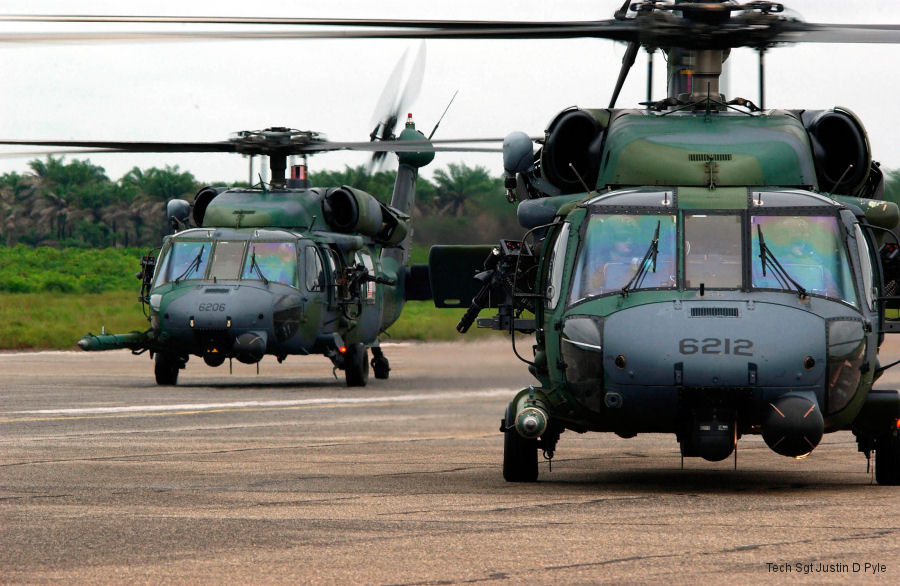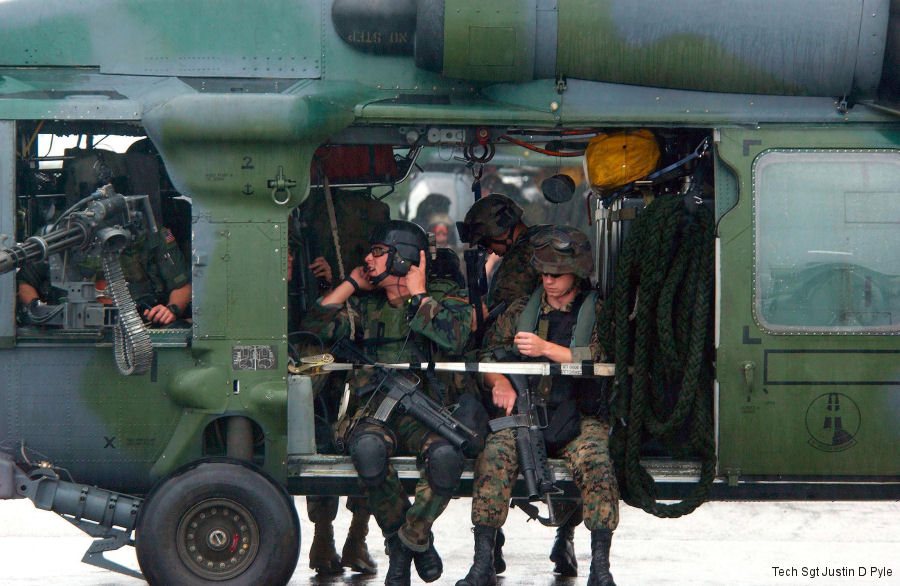US Air Force, July 23, 2003 - LUNGI, Sierra Leone by Capt Kristi Beckman - Air Force HH-60G Pave Hawk helicopters flew a Marine antiterrorism security team to the U.S. Embassy in Monrovia, Liberia, on July 21, according to officials here. They also evacuated 23 people.
The airmen and helicopters are assigned to the 56th Expeditionary Rescue Squadron from Naval Air Station Keflavik, Iceland. They are based at an intermediate staging base. The action comes in the wake of growing civil unrest in Liberia.
The 41 Marines are augmenting security forces at American embassies within the U.S. European Command’s area of responsibility.
The 56th ERQS and the 786th Expeditionary Security Forces Squadron from Sembach Air Base, Germany, form the 398th Air Expeditionary Group. The units have been providing recovery and emergency evacuation capability for the humanitarian assistance survey team in Liberia since July 13.
“Since their arrival, the … entire team (has) conducted extensive mission planning to include possible courses of action and contingencies,” said Capt. Sonny Noyes, 398th AEG battle staff director.
A mission like this one is not easy, according to 1st Lt. Jarrett Lee, a 786th ESFS combat ground intelligence officer.
“We need to plan for different scenarios such as where we’ll stage for fuel, where our alternate airfields will be, and if there’s an in-flight emergency, where would we stop,” he said. “If the environment changes and different courses of action show themselves that weren’t planned, that’s when flexibility is the key.”
The airmen had to be flexible for the July 21 mission, according to Tech. Sgt. Michael Griffin, a 56th ERQS flight engineer and gunner.
“We took up to nine combat-loaded Marines and cargo per aircraft and flew over the water right (onto) the helipad at the embassy,” said Griffin. “One helicopter landed while the other two held over the water. We took turns until all Marines were off-loaded and the people were picked up.”
Griffin said the first time the airmen went in, they got a report from the embassy that there was mortar fire within 300 meters.
“We left to unload the passengers,” he said. “Then, on the trip back to the embassy … they held us because of the heavy mortar fire.”
The mortars came as a surprise, according to Lt. Col. Thomas Sexton, the 56th ERQS deployed squadron commander.
“We felt no sense of immediate danger, and the way the people were standing around in the embassy, we could tell they didn’t feel any danger either,” he said. “The mortar fire probably came as a huge surprise to them as well.”
The helicopters flew the Marines into the embassy, met up with a deployed MC-130P Combat Shadow from Royal Air Force Mildenhall, England, and then flew back to a staging area to pick up more Marines, according to Col. Steven Dreyer, the 398th AEG commander.
A security team from the 786th ESFS controlled the forward-staging area. The team included security forces, a communications specialist and a medical technician.
“The forward-staging area was important because it shortened the crew’s flying time and allowed us to get more birds into the embassy at any given time,” said Maj. James Lowe, the 786th ESFS commander. “We provided communications between the staging base at the tactical operations center at Lungi and the forward-staging area.”
The planning paid off, said Sexton.
“Everything flowed smoothly, according to plan,” he said. “We’ve been talking to the 786th SFS since April planning a separate exercise, so we knew their capabilities.
“We can support them with increased security protection and airlift, and they can give us base-operations support,” Sexton said.
“The mission went well,” said Dreyer. “The extensive planning we did paid off. We knew there was a chance of enemy fire and were prepared.”
The airmen and helicopters are assigned to the 56th Expeditionary Rescue Squadron from Naval Air Station Keflavik, Iceland. They are based at an intermediate staging base. The action comes in the wake of growing civil unrest in Liberia.
The 41 Marines are augmenting security forces at American embassies within the U.S. European Command’s area of responsibility.
The 56th ERQS and the 786th Expeditionary Security Forces Squadron from Sembach Air Base, Germany, form the 398th Air Expeditionary Group. The units have been providing recovery and emergency evacuation capability for the humanitarian assistance survey team in Liberia since July 13.
“Since their arrival, the … entire team (has) conducted extensive mission planning to include possible courses of action and contingencies,” said Capt. Sonny Noyes, 398th AEG battle staff director.
A mission like this one is not easy, according to 1st Lt. Jarrett Lee, a 786th ESFS combat ground intelligence officer.
“We need to plan for different scenarios such as where we’ll stage for fuel, where our alternate airfields will be, and if there’s an in-flight emergency, where would we stop,” he said. “If the environment changes and different courses of action show themselves that weren’t planned, that’s when flexibility is the key.”
The airmen had to be flexible for the July 21 mission, according to Tech. Sgt. Michael Griffin, a 56th ERQS flight engineer and gunner.
“We took up to nine combat-loaded Marines and cargo per aircraft and flew over the water right (onto) the helipad at the embassy,” said Griffin. “One helicopter landed while the other two held over the water. We took turns until all Marines were off-loaded and the people were picked up.”
Griffin said the first time the airmen went in, they got a report from the embassy that there was mortar fire within 300 meters.
“We left to unload the passengers,” he said. “Then, on the trip back to the embassy … they held us because of the heavy mortar fire.”
The mortars came as a surprise, according to Lt. Col. Thomas Sexton, the 56th ERQS deployed squadron commander.
“We felt no sense of immediate danger, and the way the people were standing around in the embassy, we could tell they didn’t feel any danger either,” he said. “The mortar fire probably came as a huge surprise to them as well.”
The helicopters flew the Marines into the embassy, met up with a deployed MC-130P Combat Shadow from Royal Air Force Mildenhall, England, and then flew back to a staging area to pick up more Marines, according to Col. Steven Dreyer, the 398th AEG commander.
A security team from the 786th ESFS controlled the forward-staging area. The team included security forces, a communications specialist and a medical technician.
“The forward-staging area was important because it shortened the crew’s flying time and allowed us to get more birds into the embassy at any given time,” said Maj. James Lowe, the 786th ESFS commander. “We provided communications between the staging base at the tactical operations center at Lungi and the forward-staging area.”
The planning paid off, said Sexton.
“Everything flowed smoothly, according to plan,” he said. “We’ve been talking to the 786th SFS since April planning a separate exercise, so we knew their capabilities.
“We can support them with increased security protection and airlift, and they can give us base-operations support,” Sexton said.
“The mission went well,” said Dreyer. “The extensive planning we did paid off. We knew there was a chance of enemy fire and were prepared.”
HH-60G Pave Hawk 88-26109 89-26212 89-26206 ( US Air Force )
See also |
HH-60G Pave Hawk in






